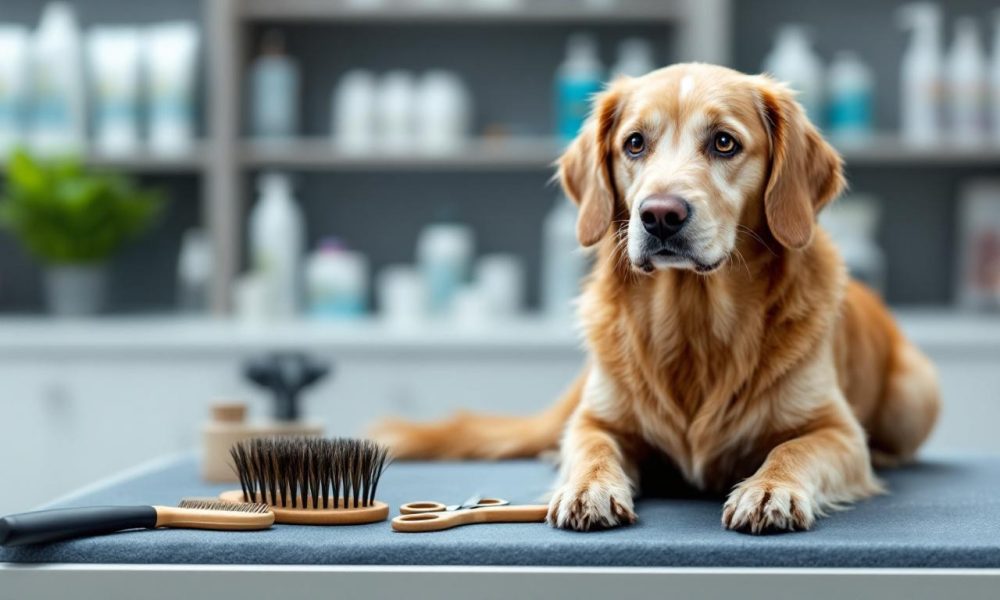Introduction to Dog Grooming
At DogingtonPost, we understand that grooming your furry friend can be a daunting task, especially for new pet parents. However, with the right tools and techniques, it can become a enjoyable bonding experience for both you and your dog. Regular grooming is vital for your dog’s health and happiness.
Essential Dog Grooming Tools
Dog grooming doesn’t have to be complicated. The right tools can make this task a breeze. Let’s explore the must-have items for your dog grooming kit.
Brushes and Combs: Tailored for Every Coat
The type of brush you need depends on your dog’s coat type. Short-haired breeds thrive with rubber brushes or grooming mitts. Medium to long-haired dogs need slicker brushes and metal combs. For dogs with medium-length coats, you can use a slicker brush or pin brush. Dogs with long coats need a pin brush or slicker brush. Heavy shedders benefit from de-shedding tools, which can reduce shedding by up to 90%.
Nail Care: Keeping Paws in Top Shape
There are two main types of nail clippers: guillotine and scissor-style. For dogs who dislike clippers, an electric nail grinder offers a quieter alternative. Always keep styptic powder nearby in case of accidental cuts. Try to trim your dog’s nails every 3-4 weeks to prevent discomfort and mobility issues.
Bath Time Essentials: Beyond Just Soap
High-quality, dog-specific shampoos are a must. Oatmeal-based formulas work well for sensitive skin. Dogs with skin issues might need medicated shampoos, which should be prescribed by a vet. Don’t skip the conditioner for a silky smooth coat!
Ear and Dental Care: Small Tools, Big Impact
For ear cleaning, use a vet-approved solution and cotton balls. Never insert anything into the ear canal. Dental care requires a dog-specific toothbrush and toothpaste. Your pet’s teeth and gums should be checked at least once a year by your veterinarian for early signs of problems and to keep your pet’s mouth healthy.
The Investment in Quality Tools
Quality grooming tools might seem expensive initially, but they’re cost-effective in the long run. They can reduce the need for professional grooming services, which typically cost $30 to $90 per session.
How to Groom Your Dog Like a Pro
Now that we’ve covered the essential tools, let’s move on to how you can use them effectively in your grooming routine.
Brushing: The Foundation of Good Grooming
Start your grooming routine with a thorough brush. Use a rubber brush or grooming mitt 2-3 times a week for short-haired dogs. Medium to long-haired breeds need daily brushing with a slicker brush or pin brush. Always brush in the direction of hair growth to avoid irritation.
Bath Time: More Than Just Getting Wet
Bathe your dog every 4-6 weeks, or more frequently if they’re particularly active outdoors. Use lukewarm water and dog-specific shampoo. Start at the neck and work your way down, but avoid the eyes and ears. Rinse thoroughly, as leftover shampoo can cause skin irritation.
Nail Care: Trimming Without the Drama
Trim your dog’s nails every 3-4 weeks. If you hear clicking on the floor when they walk, it’s time for a trim. Use either guillotine or scissor-style clippers, depending on your preference. Cut small amounts at a time to avoid hitting the quick, the blood vessel inside the nail.
Ear and Dental Care: Often Overlooked, Always Important
Clean your dog’s ears weekly with a vet-approved solution. Never insert anything into the ear canal. For dental care, brush your dog’s teeth at least 2-3 times a week with a dog-specific toothbrush and toothpaste.
Tackling Matted Fur: Patience is Key
If you encounter matted fur, don’t reach for the scissors right away. Use a detangling spray and work through the mat with your fingers or a wide-toothed comb. For stubborn mats, a mat splitter can be helpful. If the mat is too close to the skin or you’re unsure, it’s best to seek professional help to avoid injuring your dog.
Overcoming Common Dog Grooming Challenges
Establishing a grooming routine can be challenging, especially when faced with common issues such as nervous dogs, skin irritations, excessive shedding, odor issues, and special needs.
Calming Nervous Dogs During Grooming
Many dogs experience anxiety during grooming sessions. To help your nervous pup, create a positive association with grooming tools. Allow your dog to sniff and investigate brushes and clippers before use. Offer treats and praise throughout the process.
Addressing Skin Irritations and Allergies
Skin issues can make grooming uncomfortable for your dog. If you notice redness, flaking, or excessive scratching, consult your veterinarian to rule out underlying health problems. For mild skin irritations, use a hypoallergenic, oatmeal-based shampoo.
Managing Excessive Shedding
Shedding is a natural process, but excessive fur loss can frustrate pet owners. Regular brushing is your best defense against shedding. For heavy shedders, brush daily using a deshedding tool.
Tackling Odor Issues
Dogs can develop unpleasant odors for various reasons. Regular bathing with a high-quality dog shampoo helps control odors. For dogs with persistent odor issues, try an enzymatic cleaner designed to break down odor-causing bacteria.
Grooming Dogs with Special Needs
Dogs with physical limitations or health issues require extra care during grooming. For older dogs or those with arthritis, use a non-slip mat in the bathtub and consider a handheld shower attachment for easier bathing.
Conclusion
Regular grooming improves your dog’s health and strengthens your bond. With practice and patience, you’ll master brushing, bathing, nail trimming, and dental care. Establish a consistent grooming routine that suits both you and your pet. Don’t get discouraged if you face challenges – every dog is unique, so it may take time to find the perfect approach for your furry friend. By following these dog grooming tips for beginners, you’ll be well on your way to providing the best care for your canine companion.

